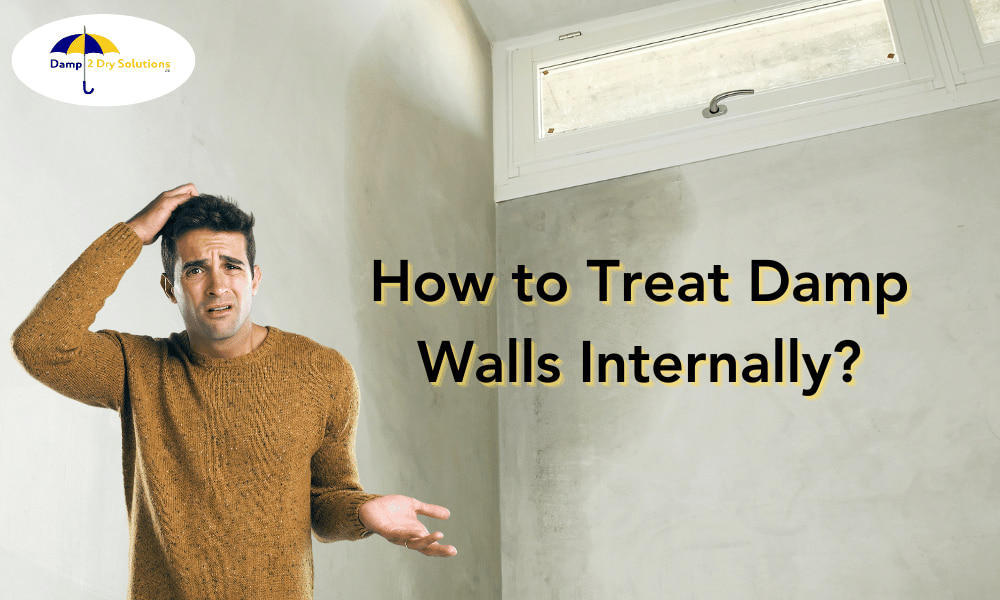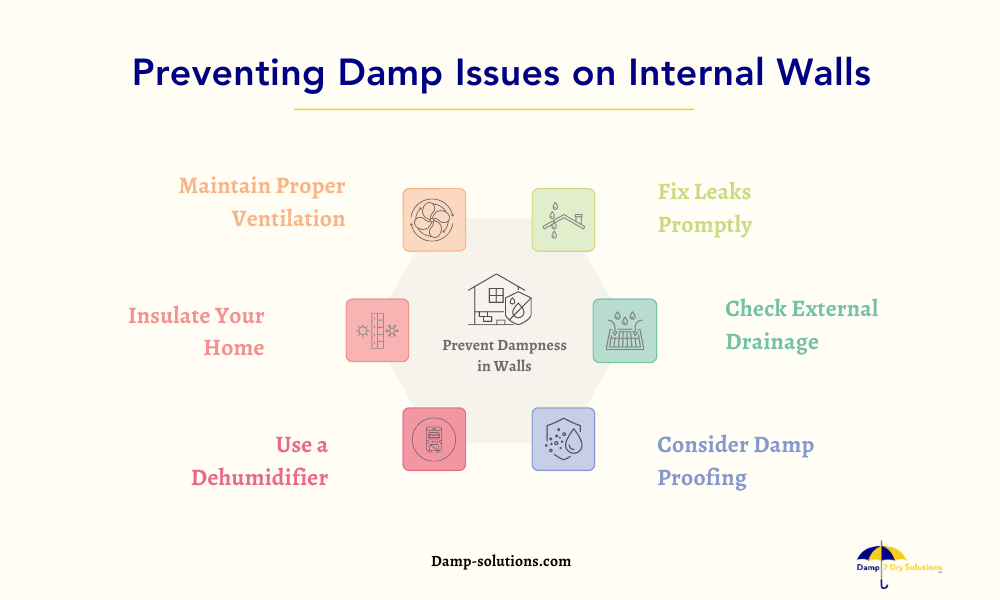
Dampness is a very common issue and can be found in the majority of houses today. Therefore, it is the need of the hour to address this problem with utmost seriousness. If the problem of
Damp Internal Walls
increases, it can degrade the beauty of your house and can also prove to be harmful to your health to a large extent.
Well, there are infinite guides available in the market in regard to dealing with the issue of
Damp Internal Walls,
but there is still much confusion relating to this rapidly growing problem.
This blog will highlight the primary causes of dampness existing within internal walls, the root causes of the condensation dampness within internal walls, permanent solutions to fix it, and much more.
As it is crucial to analyse the causes of dampness to eliminate the problem at its source, let’s begin by identifying the primary factors contributing to the dampness within your walls.
What causes the dampness to rise within internal walls?
There are various causes for the increasing dampness within internal walls. Certain reasons help us understand clearly the active driving force behind the presence of heavy moisture in the walls internally.
Following is a list of the top causes of dampness within your walls:-
- Failure to Construct a Proper Water-Repellent Structure:-
Dampness may occur in your internal walls if the water-repellent structure is not built properly, or if there are certain defaults in making the system. It also happens in case the repellant system has been degraded or has become too old.
- Defective Drain Pipes:- Another significant cause of dampness inside your walls can be damaged drainpipes. If there are any leaks in the guttering, it can lead to a high level of moisture accumulation within the walls. Therefore, it’s essential to ensure that the drainpipe is intact, without any cuts or weaknesses along its length.
- Crumbs in the Roof Tiles:-
When small cracks start taking place in the roof tiles, it can also cause water leakage from a particular source. Little cracks will allow the water to move through it which will result in creating a high level of moisture in your internal walls.
- Condensation:-
You may have felt hot moist air present in your room sometimes. When this warm wet air gets associated with the cold internal surface of your wall, we call it Condensation. It can certainly give birth to high dampness inside your walls.
Amongst all these causes, condensation is the most common form of dampness which can be easily found even in well-built structures. You may also have suffered from this kind of problem sometimes. It can even create health-related concerns. Therefore, it is important to deal with the issue at the proper time and with the proper solution. So, in the next section of this study, we will be going to discuss the primary causes of condensation dampness to get an idea of why such a problem arises.
What causes condensation dampness on internal walls?
As we have already discussed Condensation in the above section, let’s briefly try to understand its basic essence in short.
You may have seen little humid spots occurring on the surface of your walls, which makes the appearance of your house ugly to a large extent. This is known as Condensation dampness.
This problem can be generally caused due to the:
-
Improper construction of the gutters
-
Destruction to the roof
-
Rupture in the mortar of your wall
-
Defects in the things attached or screwed to the wall
Do Internal Walls Need Damp Proofing?

The answer is Yes.
Damp-proofing provides strong support to the structure of walls, which acts as a resistance against dampness. So, it plays a significant role in making the composition of your walls healthy and rejuvenating.
In addition, the Damp-proofing paint manages to eliminate the dampness existing within walls, and it also does not allow the humid moist air to enter the internal surface of the structure.
So, we can say that Damp Proofing is a must to ensure the integrity of your walls and uplift the standards of your composition on a vast scale. Every individual must install an effective water-repellant system in their houses to escape the problem of dampness.
How to treat rising dampness on internal walls
We got a preliminary idea about the importance of Damp-proofing in the above text. Now, in this section, we will highlight some of the measures that have to be adopted to deal with the dampness on internal walls.
Before moving further to the solutions, it is important to analyze the root factor that has given birth to the moisture within your walls. Identifying the major force that is causing the problem of dampness repeatedly would help you resolve the issue properly.
In addition, it must be noted if the problem of rising dampness is not inspected in proper accordance before taking any actions, then it might occur regularly. Therefore, a deep analysis of the causes of rising dampness is one of the most important parameters in determining an efficient network of solutions to the problem.
As we have already discussed the primary causes of rising dampness in the aforementioned parts of the study. Now we will look at some of the effective measures that you must adopt to treat the rising dampness inside your walls.
Major Remedies to Eliminate the Problem of Rising Dampness Utilizing Chemicals Yourself Through DIY Damp-Proofing:-
- Must use a Rotary tool:-
It is advised to use a rotary tool for making holes about 12 mm broad in the wall.
- Must use the Rotary tool through the outer and inner walls:-
You have to use the drill in such a manner that it may be able to make holes in the external as well as inner structure of the wall.
- Must use the Rotary tool as specified in the Damp-proof training manual:-
It is recommended to perform drilling as per the standards laid down in the Damp-proof course manual in relation to implementing the methodology and structural design.
- Should Use a Pump to give proper direction to the liquid:-
You can use a pump that may contain a good force for exerting the liquid into the walls. It will help generate a damp-proof shield around your walls to restrict the way of dampness to your home from downwards.
- Should use mortar to cover the holes:-
It is directed to use mortar for covering the holes made by you at the point of damp-proofing to restrict the rainwater entering your home.
- Leave the mortar to become dry:-
Now, wait for the mortar to become dry prior to initiating any further repairs to your wall.
How to repair a damp internal wall?
Firstly, it must be noted that after creating a water-repellent shield around your walls, it is necessary to analyze how a damp internal wall can be repaired. Before starting with the procedure of repairing the damp wall internally, you have to keep in mind that at the preliminary stage, it is essential to remove the defective plaster.
As in the above section, we have already discussed the solutions to rising dampness on internal walls. Now, let’s have a look over the procedure for repairing a damp internal wall.
The following measures should be adopted to restructure the damp internal wall:-
- Find the root cause and resolve it:-
First, it is required that you trace the root cause of the damp internal wall and resolve it as soon as possible prior to moving forward with the procedure.
- Use a Dehumidifier:-
You can use the dehumidifier to make the room dry which will not permit moisture in the room, and allow to create an anti-resistant platform against the damp internal walls.
- Use a Stain Blockade:-
In order to remove any blotches, you need to use a Stain Blockade. It will help to clear the dirty marks and make the composition look beautiful.
- Plaster your walls again:-
It is much needed to perform the replastering of your walls. It will act as a powerful support system to give strength to the structure of your walls to fight against the problem of dampness.
- Again apply damp-proofing paint:-
You can make a composition of damp-proofing paint and reapply it on the walls to improve the capacity of the structure. You should also add new tiles and wall decoration items to repair your damp internal wall.
How to treat damp walls before painting?
It is mandatory for you to be careful when dealing with damp walls before painting. You have to take care of a lot of things in this regard to ensure proper maintenance of the walls.
So far we have discussed the repairing procedure for the dampness existing within the walls. Now, let’s try to understand the steps for curing damp walls prior to painting.
Furthermore, there are many measures to deal with the damp walls before painting. Here, we are going to enshrine some of the crucial treatment steps that can help you deal with your damp walls before painting.
Following is a list of preventive measures for treating damp walls prior to painting:-
- Restricting moist or mold blotches:-
In order to avoid any kind of moist blotches on the surface of the wall, you should clean the defective areas with a branded moist remover spray or washbar.
- Fixing the crumbs and holes:-
It is recommended to use a water-repellant plaster to cover the crumbs or holes. Plaster patches are best suited for resolving large problems, whereas sealant can be used for dealing with smaller problems.
- Provide relaxation to the area:-
After the drying of your plaster, give relaxation to the specific region to increase its flexibility and make it more adaptable to the external environment.
- Clean away the remaining:-
You must use your wash bar and re-spray to clean away the remaining. After that, you have to leave your walls to dry during the whole night.
- Implementation of a water-resistant source:-
Applying the damp seal paint helps restrict the dampness from entering the walls on a wide scale. It also provides new strength and longevity to the structure, and there remains a very low possibility for moisture to enter the wall.
- Color the walls:-
After the materials applied to the composition become dry, you have to color the walls. You can choose your favorite texture and accordingly paint your walls in an attractive manner.
Dealing with damp internal walls professionally
We covered the treatment measures for damp walls before painting in the above section. Now, it becomes important to answer the question of how we can deal with this problem at the professional level.
In addition, many questions may be bubbling into your mind. What are the initiatives that must be taken by an individual to handle the problem of damp internal walls? Don’t let your brain be confused in finding a reliable platform to effectively deal with this issue smoothly.
can help you resolve this issue by offering guidance from experienced professionals in the field. Contact our damp specialist at Damp 2 Dry Solutions to assess the root causes and remedies for excessive moisture in your structure by completing the required form.
Preventing Damp Issues on Internal Walls

Preventing damp issues on internal walls is just as important as knowing how to treat them. Here are some tips to help you avoid damp problems in the first place:
- Maintain Proper Ventilation: Good ventilation is essential to reduce humidity levels inside your home. Ensure that your rooms have adequate airflow, especially in areas prone to moisture build-up like kitchens and bathrooms. Consider using extractor fans or opening windows regularly to allow fresh air in.
- Fix Leaks Promptly: Any leaks in your plumbing or roof can lead to dampness on internal walls. Regularly inspect your home for leaks, and address them as soon as they’re discovered.
- Insulate Your Home: Proper insulation can help regulate indoor temperature and reduce the chances of condensation forming on walls. Make sure your home is well-insulated to prevent cold spots where moisture can accumulate.
- Use a Dehumidifier: In particularly humid climates, using a dehumidifier can help maintain the right humidity levels inside your home, reducing the risk of condensation dampness.
- Check External Drainage: Ensure that rainwater is effectively drained away from your property. Faulty drainage systems can lead to water seeping into the walls from the outside.
- Seal Gaps and Cracks: Seal any gaps or cracks in your walls and around windows and doors to prevent rainwater infiltration.
- Regular Maintenance: Perform routine checks on your internal walls for signs of dampness. Early detection can help prevent the issue from worsening.
- Consider Damp-Proofing: If you live in an area prone to damp problems, you may want to consider professional damp-proofing solutions for your internal walls as a preventive measure.
How much does it cost to damp-proof an internal wall?
After talking about how we can manage the problem of dampness in an official manner, lastly, let’s conclude the article by highlighting the cost of damp-proofing an internal wall.
Firstly, it must be clear that the cost of damp-proof varies from country to country. It totally depends on the business networking, the influence of services, and the established brand value of the service provider in the country.
For instance, in the UK, the cost of providing damp-proofing services ranges from £300 to £400. However, it can also extend to £300 to £5000 depending on the advanced management of the problem. It may also be highly reliable on the location of the UK in which you are living.
If you’re searching for experienced and professional damp contractors, you needn’t look any further than Damp 2 Dry Solutions. We provide treatments for rising damp, condensation control, woodworm eradication, and timber treatments throughout Cheshire, Manchester, Lancashire, Liverpool, Merseyside, Sheffield, Stoke-on-Trent, and all surrounding areas.
Get in touch we will be happy to offer you our full service starting with a No-Obligation Damp Survey to asses your problems and recommend solutions.

